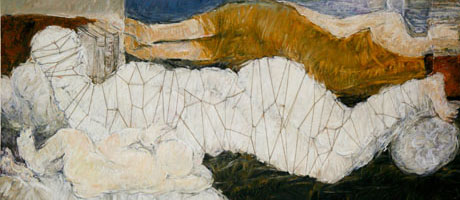 |








  
|
 |
 |

YOU KHIN (1947 - 2009)
Collection Overview | Biography | Chronology | Images | Press



You Khin - Biography
Born in a village along the Mekong River on March 2, 1947 in Cambodia, You Khin was the last of seven children. His childhood was spent on the Mekong Delta where he drew on the sand and learned traditional painting from his uncle who painted scenes of Buddha's life in Kampong Cham temples.
At a young age, Khin's parents sent him to the capital, Phnom Penh to live with his uncle and pursue his studies. After high school he left his uncle's home to go live at the Watt Botum Temple, near the Royal Palace. He enrolled at the Royal University of Fine Arts to study Interior Architecture. Even as a teenager, Khin was an active community member and prolific artist. He was actively involved in the arts scene by participating in various exhibitions in Phnom Penh and was elected president of the student union. Unfortunately, the art world will never be able to enjoy Khin's early works because the Khmer Rouge destroyed all of his paintings from this period.
In 1973, he graduated from the Royal University of Fine Arts with a degree in Interior Architecture. After graduation, he left Cambodia on a French scholarship to study Three Dimensional Decorative Arts in Marseilles at the Luminy School of Fine Arts where he graduated in 1974.
While in France, Khin became a French citizen and went to work as an architect in Sudan and the Ivory Coast from 1977 to 1981. Much of his early works reflect the tremendous culture shock he felt while living in Sudan. Cambodia was poor but in Sudan he saw devastating poverty more than he had ever imagined possible. Yet, he found the Sudanese people to be kind and patient. Their silhouettes, their gestures, and their postures impressed him. The way Sudanese women dressed and the bustling market scenes inspired him. His first exhibitions were immediate successes and encouraged him to refine and search for a new technique.
His paintings of street scenes, markets and people typically included birds. Khin personally identified with the birds as symbols of freedom and freedoms lost. Living abroad during the Khmer Rouge years, the loss of freedom in his country preyed heavily on his mind and as a tribute to his fallen compatriots, he caged the birds and added locks and chains to symbolize oppression.
Khin and his family moved to the Ivory Coast in 1979 where he exhibited at the French Cultural Centre. He liked to capture scenes of everyday life and paint African women working. However, even as he was experiencing new cultures and traveling the world, Cambodia was still on his mind. It was during this period that birds as a symbol of freedom began to appear more frequently in his paintings. This was an introverted period in his work.
Later on Khin and his family moved to Qatar in the Middle East, before settling in London in 1999. In London, Khin participated in several exhibitions and had a solo show at the Riverside Gallery in Richmond upon Thames. Women now appeared as the central thematic narrative in his paintings. Khin was still tuned into global events and after "9/11" an injured Liberty became a central figure of his work. Feet, shoes and boots were recurrent subjects as they became metaphors for man's pursuit of peace and happiness. It was during this time that Khin first employed his firm, impressionistic brush stroke, very much reminiscent of Vincent Van Gogh but with a softer color palette similar to Monet.
Some years after the dismemberment of the Khmer Rouge, Khin's wife Muoy returned in 2003 to Cambodia. With restored peace, Khin was able to join her in 2004. Full of hope, he imagined a Cambodia that was open to change and ready for progress but soon realized that it was just a dream. Corruption, nepotism and greed were everywhere in society, even religion had become perverted. Current problems in politics and moral attitudes crept into the narrative of his paintings and his work was more conceptual and ironic. Strings began to invade his canvas to symbolize how all members of society are bound together even though nobody seemed to realize the connections. Dancers also appeared in his paintings and his comment was "they just dance to their heart's content and don't care."
During his later years in Cambodia, Khin's works grew in size proportionate to his disillusionment of a new future for Cambodia. He no longer painted clusters of people but instead focused on larger single or tandem groups of images. His colors became subdued, metaphoric for the political and moral state of the people and shades of grey permeated his canvas, reflecting life in Cambodia.
You Khin's final series were predominantly surrealistic portraits of women. "My art tries to depict the condition of women," he says, "conditions that sometimes are far from enviable!" In his work, It's the Book, not the Bed, Khin depicts a dreamlike scene of a woman lying on human-sized books. "She is an illiterate," Khin says. "For her, it's a bed not a book," Khin explains. "Nobody has told her - not her parents, not society." The inequality of women and their suffering runs as a strong theme through most of Khin's work.
More than 30 years after his departure from Phnom Penh, You Khin's work was exhibited in his native Cambodia. His exhibition, Women at the French Cultural Center in Phnom Penh, June of 2009, was met with astounding praise and recognition of his importance as a key figure in Cambodian art history. You Khin died suddenly in August of 2009 from lung cancer, he was 62 years old.
|